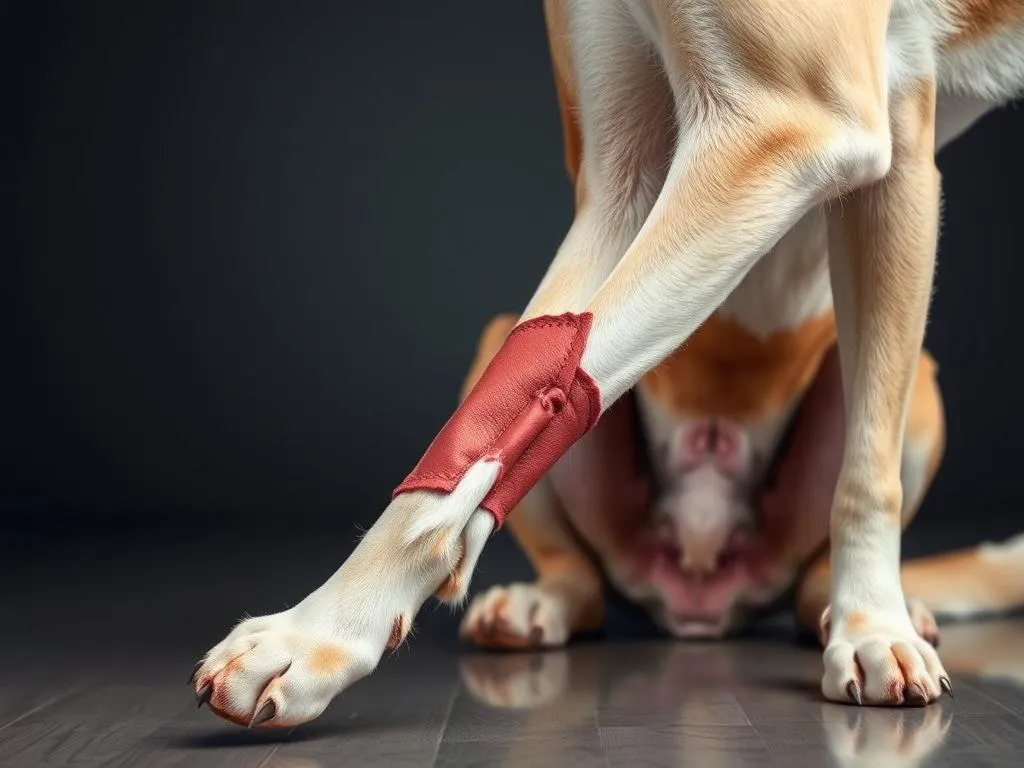
Understanding dog injuries is crucial for any pet owner. Dogs, being active creatures, can often find themselves in situations that lead to leg injuries, which can be distressing for both the pet and the owner. Among the common leg injuries, fractures and sprains are frequently encountered. Knowing the difference between a broken leg and a sprained leg can significantly affect the treatment approach and speed of recovery.
Timely veterinary care and intervention are essential when a dog suffers a leg injury. Recognizing the signs and symptoms of leg injuries can help ensure your furry friend receives the appropriate care. Let’s delve into the nuances of these injuries, how to identify them, and what steps to take if your dog is hurt.
Understanding Dog Leg Injuries
Types of Leg Injuries
Leg injuries in dogs can be classified mainly into two categories: fractures and sprains.
- Fractures are breaks in the bone that can occur due to trauma, such as accidents or falls. They can be complete or partial, and the severity can vary widely.
- Sprains, on the other hand, involve the stretching or tearing of ligaments—the bands of tissue that connect bones to joints.
Common causes of leg injuries in dogs include accidents during play, falls from heights, sports-related activities, or even underlying health conditions that predispose them to injuries.
Symptoms of Leg Injuries
When it comes to leg injuries, there are general symptoms to look for, including:
- Limping: A noticeable alteration in the way your dog walks.
- Swelling: This can occur in the area around the injury.
- Pain: Dogs may react negatively when the injured leg is touched.
Symptoms can differ between fractures and sprains. While both injuries might present with limping and swelling, fractures typically involve more severe pain and may result in visible deformities.
Signs Your Dog May Have a Broken Leg
Observable Symptoms
If you suspect your dog’s leg is broken, look for these signs:
- Severe limp or inability to bear weight: If your dog is unable to put weight on the injured leg, this could indicate a fracture.
- Visible deformity or swelling: Swelling may be localized, but if the leg appears misshapen or crooked, it’s a strong indicator of a break.
- Unusual sounds: If you hear cracking or popping noises when your dog moves, it could suggest a fracture.
Behavioral Indicators
Behavioral changes can also signal a broken leg:
- Changes in behavior: If your dog becomes aggressive or withdrawn when moving or having the leg touched, this may indicate pain.
- Signs of pain: Whining, yelping, or flinching when you approach the injured area can be a clear sign of distress.
Signs Your Dog May Have a Sprain
Observable Symptoms
When it comes to sprains, the signs may be more subtle:
- Mild to moderate limp: Your dog may still be able to bear some weight but will likely favor the injured leg.
- Localized swelling without a noticeable deformity: You may notice some swelling, but the leg will retain its normal shape.
- Some weight-bearing ability: Dogs with sprains often can still put some weight on the leg, unlike those with fractures.
Behavioral Indicators
Observing behavioral changes can also help differentiate a sprain from a fracture:
- Reluctance to engage in physical activity: If your dog is hesitant to run or play, it may be trying to protect the injured leg.
- Change in posture or gait: An altered stance or an awkward way of walking may indicate discomfort.
How to Assess Your Dog’s Injury
Initial Assessment at Home
If you suspect your dog has sustained an injury, follow these steps for an initial assessment:
- Keep your dog calm and still: This is crucial to avoid further injury.
- Examine the leg carefully: Look for swelling, deformities, or open wounds.
- Monitor their behavior: Note any signs of pain when the leg is touched or when they attempt to move.
When to Seek Veterinary Help
Knowing when to consult a veterinarian is critical:
- If your dog is unable to bear weight on the leg, seek immediate veterinary assistance.
- Visible deformities or excessive swelling warrant a trip to the vet.
- If your dog shows signs of severe pain, such as constant whining or aggression, don’t wait for symptoms to worsen.
Diagnostic Procedures
Common Diagnostic Tests
Veterinarians will typically conduct a physical exam and may recommend diagnostic tests such as:
- X-rays: Essential for confirming fractures, as they provide clear images of the bone structure.
- Physical exams: A thorough examination of the affected area will help determine the extent of the injury.
What to Expect at the Vet
During your visit, you can expect the following:
- Check-in and examination: The vet will ask about the injury and perform a physical examination.
- Discussion on possible treatments: Depending on whether it’s a fracture or a sprain, the vet will explain the treatment options available.
Treatment Options
Treatment for Broken Legs
If your dog has a broken leg, treatment options may include:
- Surgical options: Severe fractures may require surgery to insert pins or plates to stabilize the bone.
- Recovery process and aftercare: Post-surgery, your dog may need restricted activity and regular follow-up visits for monitoring healing.
Treatment for Sprains
For sprains, treatment generally involves:
- Conservative management: Rest, ice, and compression can be effective in reducing swelling and pain.
- Rehabilitation exercises and therapies: Once the initial pain subsides, your vet may recommend physical therapy to restore mobility and strength.
Preventative Measures
Keeping Your Dog Safe
Preventing leg injuries is possible with a few proactive strategies:
- Tips for reducing risks: Keep your dog on a leash during walks, supervise them during play, and remove hazards from your home and yard.
- Importance of strength and conditioning activities: Engaging in regular exercise tailored to your dog’s breed and age can help maintain their physical condition and reduce the risk of injuries.
Regular Veterinary Check-ups
Routine veterinary visits are crucial for maintaining your dog’s health:
- Routine check-ups can help prevent injuries: Regular exams allow for early detection of potential health issues that could lead to injuries.
- Maintaining a healthy weight: Obesity can increase the risk of injuries, so ensuring your dog maintains a healthy weight is essential.
Conclusion
In summary, recognizing the signs of whether your dog’s leg is broken or just sprained can make all the difference in their recovery. Pay close attention to observable symptoms and behavioral changes, and don’t hesitate to seek veterinary advice when needed. Monitoring your dog’s health and understanding the nature of their injuries is vital in ensuring their well-being. By being proactive, you can help your furry friend bounce back to their playful self in no time.









